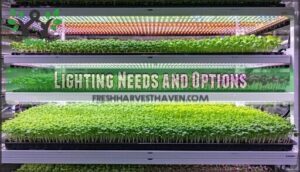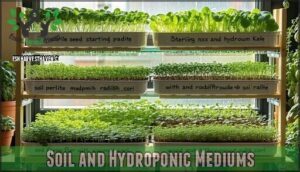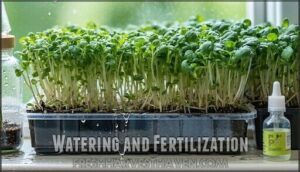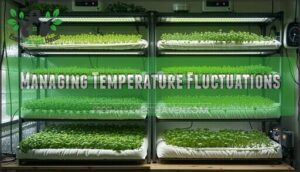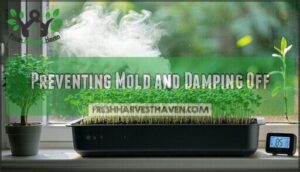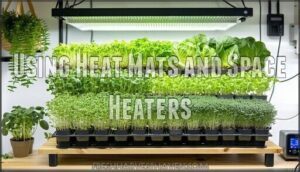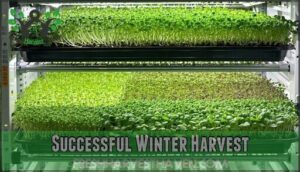This site is supported by our readers. We may earn a commission, at no cost to you, if you purchase through links.

You’ll want temperatures between 65-75°F, which most homes maintain anyway. The real game-changer is lighting; LED grow lights work perfectly when natural light falls short.
Choose fast-growing varieties like radish, arugula, or pea shoots that’ll be ready in 7-14 days. Use shallow trays with quality potting mix or hydroponic mediums, and keep the soil consistently moist but not soggy.
Good air circulation prevents mold, your biggest winter enemy. With successive plantings every week, you’ll have fresh greens when outdoor gardens lie dormant.
Master these basics, and winter’s cold grip won’t stop your green thumb.
Table Of Contents
- Key Takeaways
- Growing Microgreens Indoors
- Winter Microgreens Requirements
- Indoor Growing Conditions
- Overcoming Winter Growing Challenges
- Successful Winter Harvest
- Frequently Asked Questions (FAQs)
- Can you grow microgreens in winter?
- Can you grow microgreens indoors year round?
- What temperature is too cold for microgreens?
- What is a possible downside to microgreens?
- Can I grow microgreens without any soil?
- Which microgreen varieties grow fastest in winter?
- How much space do I need indoors?
- Are microgreens safe for pets to eat?
- Whats the shelf life after harvesting?
- Conclusion
Key Takeaways
- You’ll need consistent temperatures between 65-75°F and 12-16 hours of LED grow lights daily since winter’s natural light isn’t sufficient for healthy microgreen growth.
- Choose fast-growing varieties like radish, arugula, and pea shoots that’ll mature in 7-14 days, and use bottom-watering techniques to prevent mold and root rot.
- Maintain good airflow with small fans and keep humidity between 40-60% to prevent fungal problems that thrive in winter’s cooler, damper conditions.
- Start new trays every 7-10 days using successive planting schedules to ensure you’ll have continuous harvests of fresh microgreens throughout the winter months.
Growing Microgreens Indoors
You’ll discover that growing microgreens indoors during winter is surprisingly simple and rewarding.
These nutrient-packed seedlings thrive in controlled indoor environments, requiring just basic supplies and consistent care to produce fresh greens year-round, which can be a very rewarding experience.
Choosing The Right Seeds
The right microgreen seeds winter varieties can make or break your indoor growing success.
You’ll want seeds with strong disease resistance and reliable nutrient density for consistent harvests.
- Fast-sprouting varieties like radish and broccoli offer 3-5 day sprout times
- Hardy winter microgreens such as kale and arugula handle temperature fluctuations better
- Small seed size options like mustard guarantee even germination in indoor conditions
- High seed viability ratings (85%+) guarantee better success rates for microgreen varieties winter growing.
You can easily find winter microgreen products online.
Optimal Temperature Range
Temperature control makes or breaks your indoor microgreen growing success. You’ll want to maintain 18-22°C (64-72°F) for ideal germination speed and healthy growth.
Temperature control is the make-or-break factor for thriving winter microgreens.
Temperature monitoring becomes your best friend since variety sensitivity varies substantially. Consider heating alternatives like heat mats under trays or space heaters for consistent winter microgreens production.
| Temperature Range | Growth Effect |
|---|---|
| Below 18°C (64°F) | Slow germination, stunted growth |
| 18-22°C (64-72°F) | Ideal thermostat setting, fastest growth |
| 22-25°C (77°F) | Acceptable but watch for stress |
| Above 25°C (77°F) | Heat stress, poor quality greens |
| Fluctuating temps | Uneven germination, leggy growth |
Importance of Airflow and Humidity
Your microgreens’ success hinges on proper air circulation and humidity control to prevent mold and damping off.
Good airflow and humidity control prevent mold – the silent killers of winter microgreens.
Without adequate ventilation, these tiny plants become sitting ducks for fungal problems that’ll ruin your indoor microgreen setup faster than you can say "green smoothie."
- Position fans strategically – Place small fans nearby to create gentle airflow without directly blasting delicate seedlings
- Monitor humidity levels – Keep relative humidity between 40-60% using dehumidifiers or ventilation adjustments as needed
- Space trays appropriately – Allow gaps between containers for natural air movement and easier mold prevention maintenance
Winter Microgreens Requirements
Winter changes your microgreens game completely, but you can still grow fresh greens year-round with the right setup.
You’ll need to adjust your lighting, growing medium, and watering approach to match the season’s unique challenges.
Lighting Needs and Options
Proper lighting transforms your winter indoor garden from struggling seedlings to thriving greens.
You’ll need 12-16 hours daily of full-spectrum LED lights positioned 12-18 inches above trays. LEDs offer superior efficiency and light spectrum control compared to fluorescent alternatives.
South-facing windows work if providing 4+ hours direct sunlight, otherwise supplement with growing lights for ideal microgreen setup success.
For vertical rack systems, consider LEDs because they produce minimal radiant heat.
Soil and Hydroponic Mediums
Both soil and hydroponic methods work brilliantly for growing microgreens indoors during winter months. Your choice depends on convenience preferences and growing experience level. Hydroponic systems often boast faster growth.
- Soil composition: Use sterile seed starting mix with perlite for drainage and coconut coir for water retention
- Hydroponic nutrients: Wood fiber mats or hemp mats provide clean, mess-free indoor microgreen kit setups
- Medium pH: Maintain 5.5-6.0 for hydroponics; soil naturally buffers pH levels
- Sterilization methods: Choose commercial mixes to prevent mold in microgreen trays indoor
Watering and Fertilization
Unlike surface-level sprinkling, proper watering frequency for indoor microgreen kits requires bottom-watering every 1-2 days to maintain consistent moisture without waterlogging.
Most growing microgreens indoors need minimal fertilizer types since seeds contain sufficient nutrients for their short cycle.
However, hydroponic nutrients may help prevent nutrient deficiencies in extended grows, while maintaining proper pH balance guarantees maximum uptake during indoor gardening winter sessions.
Indoor Growing Conditions
Creating the perfect indoor growing environment means you’ll need to manage temperature swings and prevent the fungal enemies that love cool, damp winter conditions.
Heat mats and space heaters become your best friends for maintaining steady warmth, while good airflow keeps mold from turning your microgreen dreams into a soggy nightmare.
Managing Temperature Fluctuations
Anyone can master temperature control for their best microgreens winter success with smart adjustments.
Winter’s unpredictable temperatures demand proactive ambient adjustment strategies for your microgreen setup indoor.
- Use insulation methods like blankets or cardboard around trays during cold snaps
- Position growing lights microgreens closer (10-12 inches) for dual heating benefits
- Practice seedling hardening by gradually exposing plants to cooler temps before harvest
Consistent warmth transforms finicky winter crops into reliable producers with these microgreen growing tips for indoor gardening winter.
To further protect against the cold, consider using organic mulch for insulation.
Preventing Mold and Damping Off
Many microgreen enthusiasts discover that good airflow and humidity control are your best defenses against fungal disasters.
Position a small fan nearby to keep air moving, space seeds evenly without overcrowding, and sanitize trays between crops.
Bottom watering prevents surface moisture buildup that encourages mold, while maintaining moderate humidity levels creates ideal winter indoor gardening conditions for healthy microgreen growth.
Using Heat Mats and Space Heaters
Heat mats provide consistent warmth that boosts germination speed for winter harvest microgreens.
These devices increase soil temperature by 10-20°F, creating ideal conditions for microgreen germination indoor.
Your placement strategy matters—position mats under trays during sprouting, then remove to prevent overheating.
Many growers source their microgreens heat mats online.
- Energy consumption: Heat mats use only 15-20W versus space heaters’ 750-1,500W
- Germination speed: Warm soil accelerates sprouting by 2-3 days
- Consistent warmth: Bottom heat prevents cold spots that hinder growth
- Alternative heating: Space heaters raise ambient temperature for large setups
- Microgreen success winter: Combine both methods for optimal indoor microgreen watering and growth
Overcoming Winter Growing Challenges
Winter growing brings unique obstacles that can frustrate even experienced gardeners, but simple adjustments keep your microgreens thriving.
You’ll face three main challenges: weak winter light that stunts growth, overwatering that leads to root rot, and maintaining just the right moisture balance.
Insufficient Light Solutions
When winter’s weak sunlight leaves your microgreens pale and leggy, supplemental lighting becomes your secret weapon.
Position grow lights 6-12 inches above trays, running them 12-16 hours daily for winter harvest microgreens success.
| Grow Light Types | Best For |
|---|---|
| Full-spectrum LEDs | Energy efficiency, long lifespan |
| T5 Fluorescents | Budget-friendly small setups |
| Compact CFLs | Limited space applications |
Watch seedling color closely—yellowing signals insufficient light duration, while proper light placement prevents stretching and promotes robust microgreen germination indoor.
Dealing With Overwatering and Root Rot
Despite your best intentions with indoor farming this winter, waterlogged soil creates the perfect storm for root rot.
Install drainage solutions like perlite-amended soil composition and bottom-watering trays.
Improve air circulation with small fans for humidity management. Space seeds properly to prevent overcrowding.
Consider organic fungicide use if problems persist in your winter gardening setup. You may also want to explore mulching for protection if you decide to move your microgreens outdoors.
Maintaining Consistent Moisture
Proper water management makes the difference between thriving microgreens and failed crops.
You’ll want moisture levels that support healthy root development without creating waterlogged conditions that invite trouble.
Here’s your moisture management strategy:
- Check substrate daily by inserting your finger about half an inch deep
- Use bottom-watering trays to deliver ideal hydration without disturbing seeds
- Maintain humidity around 50-60% for ideal seed germination conditions
- Adjust watering frequency based on your indoor temperature and lighting intensity
The key is avoiding soggy growing medium while ensuring consistent moisture for root development.
Your indoor farming setup benefits from moisture monitoring that prevents both drought stress and fungal issues.
When lighting for plants runs 12-16 hours daily, humidity management becomes even more critical.
Consider nutrient solutions only if your indoor plants show signs of deficiency, though most microgreens thrive with just water.
Successful Winter Harvest
You’ve successfully managed temperature, lighting, and moisture throughout the winter growing period, and now you’re ready to enjoy the fruits of your indoor gardening efforts.
Harvesting at the right time and setting up continuous production guarantees you’ll have fresh microgreens on your table all winter long.
Harvesting and Storage Techniques
Timing matters when harvesting your indoor plants – cut microgreens when they’re 2-4 inches tall with sharp scissors just above the growing medium.
Skip washing methods that add moisture; instead, gently pat dry and store in airtight storage containers with paper towels.
To extend shelf life, consider that temperature control is essential.
Proper harvest timing maximizes shelf life and flavor impact of your winter growing efforts.
Successive Sowings for Continuous Supply
Smart staggered planting schedules keep your kitchen stocked with fresh greens all winter long.
Start new trays every 7-10 days using weekly sowing techniques for continuous harvest cycles.
Rotate different seed varieties to maximize microgreen nutrients winter provides while maintaining year-round greens supply.
This seed rotation strategy guarantees you’ll never run out of fresh indoor gardening produce during cold months.
Troubleshooting Common Issues
When things go sideways with your winter microgreens, don’t panic.
Yellowing leaves usually signal lighting problems—bump up your LED hours to 14-16 daily. Poor seed germination often stems from cold temps or stale seeds.
For mold prevention, improve airflow and reduce watering frequency. Root health suffers from overwatering, so check moisture control by bottom-watering only.
These indoor gardening tips keep your winter garden thriving through plant growth challenges.
Frequently Asked Questions (FAQs)
Can you grow microgreens in winter?
Wonderfully warm winter weather won’t stop your microgreen mission! You’ll definitely grow fresh greens indoors using LED lights, controlled temperatures, and proper ventilation to create ideal conditions year-round.
Can you grow microgreens indoors year round?
Yes, you can grow microgreens indoors year-round with consistent temperature, adequate lighting, and proper ventilation. Winter requires supplemental grow lights since natural sunlight becomes insufficient for healthy growth.
What temperature is too cold for microgreens?
Growth slows noticeably below 21°C (70°F), making temperatures under 18°C (64°F) too cold for healthy microgreen development. You’ll need heat mats or space heaters to maintain ideal growing conditions.
What is a possible downside to microgreens?
Overwatering can trigger mold growth and damping off, especially in winter’s cooler, humid conditions. You’ll also face leggy, pale growth without adequate lighting supplementation.
Can I grow microgreens without any soil?
Like building a house without foundation stones, you absolutely can grow microgreens without soil using hydroponic methods.
Coconut coir mats, felt pads, or paper towels work perfectly as growing mediums—just add water and seeds for successful soilless cultivation.
Which microgreen varieties grow fastest in winter?
Radish and cress varieties rocket ahead in winter, sprouting within 3-5 days.
You’ll see arugula, mustard, and broccoli following close behind at 7-10 days, making them perfect choices for quick harvests.
How much space do I need indoors?
You’ll need surprisingly little space for a thriving microgreen setup. A standard 10×20 inch tray fits perfectly on most kitchen counters or windowsills, producing enough greens for daily use.
Are microgreens safe for pets to eat?
Most pets can safely enjoy specific microgreens like wheatgrass and sunflower varieties.
However, buckwheat, chives, and garlic microgreens are toxic to cats and dogs.
Consult your veterinarian first and start small.
Whats the shelf life after harvesting?
Fresh-cut microgreens stay crisp for 7-10 days when stored properly in your refrigerator.
Keep them in airtight containers with paper towels to absorb moisture, and they’ll maintain peak flavor and nutrition throughout the week, staying crisp.
Conclusion
Mastering growing microgreens in winter indoors transforms your kitchen into a year-round green oasis that outshines any grocery store produce section.
You’ve conquered temperature control, lighting challenges, and moisture management through strategic planning and proper equipment.
Your successive plantings guarantee continuous harvests while prevention methods keep mold at bay.
Winter weather no longer dictates your fresh green intake.
With these proven techniques, you’ll maintain a steady supply of nutrient-packed microgreens regardless of outdoor conditions, making winter gardening both practical and rewarding.
- https://reagtools.co.uk/blogs/news/winter-microgreens-growing-for-extra-income-in-the-cold-season
- https://www.instructables.com/Hydroponic-Microgreens-Year-Round-Indoor-Garden/
- https://simplylivingwell.com/blog-garden/how-to-grow-microgreens-indoors
- https://www.youtube.com/watch?v=j4Gfz8DMV2Q
- https://www.foodgardenlife.com/learn/grow-microgreens

